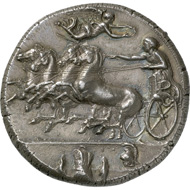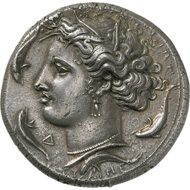By
With the kind permission of the MoneyMuseum, Zurich.
Why is it that for centuries – or, rather, thousands of years – the head has served as the motif for the side of a coin? And why has this changed in the last 200 years? Ursula Kampmann poses these questions in her book ‘MenschenGesichter,’ from which the texts for our new series are taken.
Syracuse (Sicily). Dekadrachm, 400-395 BC. A work by the engraver Euainetos, whose signature can be identified in the neck section below the dolphin.
In his guide to the sights of interest in Greece, Pausanias hands down that Arethusa was once a huntress who found herself pursued by Alpheus. But before the young man could rape the girl, the gods transformed her into a stream. In her new form, Arethusa was able to reach the island of Ortygia, the fortified centre of the city of Syracuse. Alpheus, however, turned into a river and followed the fleeing Arethusa. Even today, it’s said that his water still mingles with that of Arethusa’s to provide rich, sparkling freshwater on an island otherwise surrounded by seawater.
Aerial view of the offshore Island of Ortygia. Markos90 / http://creativecommons.org/licenses/by-sa/3.0/deed.en.
And so goes the myth, which in historical times drew on a much older ritual, as the worship of a nature deity, embodied in the stream of Arethusa, was considerably older in Syracuse. The experience of finding a freshwater source on a stony island, surrounded by the undrinkable seawater of the Mediterranean, a source that was also plentiful enough to provide for a small city, was considered by people in antiquity to be a divine act of grace. And as such, Arethusa, the stream deity who bestowed her sparkling water upon the thirsty people, came to be revered by Syracuse as a patron deity. So significant was Arethusa to the citizens that the water nymph was featured on the city’s coins virtually from the outset.
Soon enough, four dolphins swimming around Arethusa were added as an attribute. These creatures weren’t just chosen arbitrarily. In antiquity, the dolphin was considered as the animal that, sent by Apollo, signalled the ship’s safe passage. Particularly important for the success of a long ship voyage across the Mediterranean were the ports, which could put a storm-battered ship into harbour. And the Gods had truly blessed the city of Syracuse: Two ports, one large and one small, offered, according to the direction of the wind, protection from the inclement weather. In the year 734 BC, a group of Corinthian colonists are said to have discovered this ideal location for a settlement and to have occupied it. Therefore, it was chiefly its geographical location that allowed Syracuse to become one of the biggest and most important trading cities in the ancient world within a short amount of time. And its citizens saw it a gift of God.
On the reverse of their coins they depicted an aerial view likeness of their city: The spring of Ortygia in the middle, surrounded on all sides by the surging waters of the Mediterranean.
In the next chapter you’ll get to know Philip, the father of Alexander the Great, as a minting authority.
This coin is being auctioned in the May 16th/17th auction at Numismatica Ars Classica in order to help finance the new project of the MoneyMuseum on iTunes University. If you’re interested in more details about this, click here.
All sections of the series can be found here.
The book “MenschenGesichter” is available in printed form from the Conzett Verlag website. It soon will be translated to English. …








